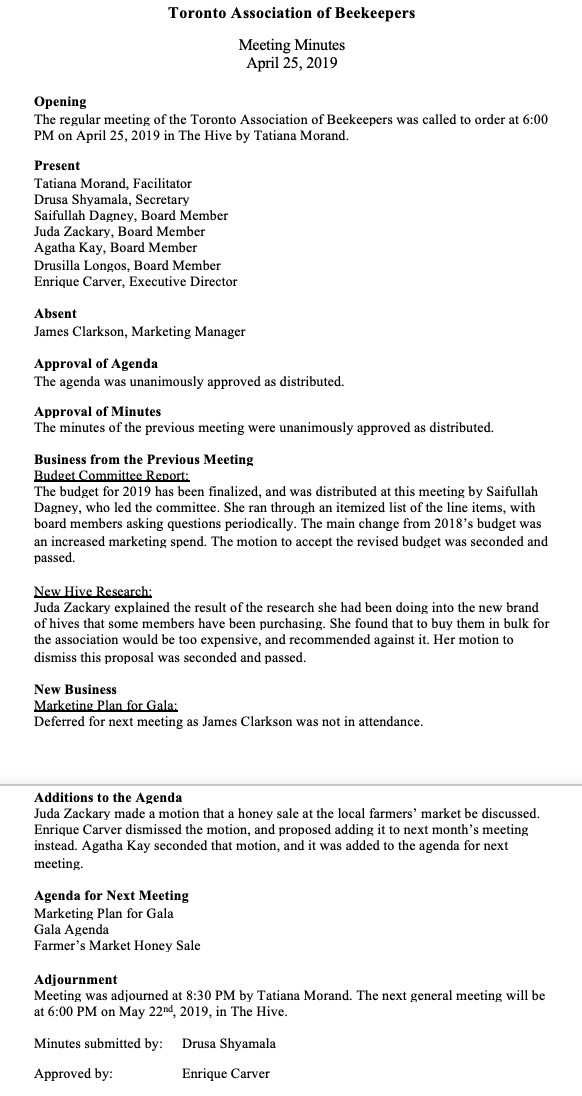


Whether you’ve been tasked with taking notes for a committee or you’ve been appointed Secretary to the Board of your organization, preparing meeting minutes doesn’t have to be an arduous task. Here are some tips and ideas that will help you get started with writing and preparing effective meeting minutes, as well as a meeting minutes sample and a meeting minutes template that you can follow. This guide on how to write meeting minutes was prepared by WildApricot to help the volunteers and/or staff of small non-profits and membership organizations who may be new to the task of taking and preparing minutes of meeting for committees or Boards of Directors.

Meeting minutes are the written record of what was discussed and decided during a meeting. They typically include the date and time of the meeting, a list of attendees, a summary of the topics discussed, decisions made, action items assigned, and the time of adjournment. Minutes are essential for providing an official account of the meeting, ensuring accountability, and helping attendees recall important details. They are usually prepared by a designated person, such as a secretary or administrative assistant, and are approved at the subsequent meeting.
For more detail on each step, read on!
Meeting minutes are typically written by the designated secretary or administrative assistant of the group or organization. In some cases, a specific member of the group may be assigned to take minutes for a particular meeting.
The person responsible for writing the minutes should be someone who is attentive, detail-oriented, and capable of accurately capturing the discussions and decisions made during the meeting.
Here’s a simple template you can refer to next time you need to take meeting minutes:
Organization Name
Meeting Minutes
Date:
Opening:
The meeting was called to order at [Time] by [Name] at [Location].
Present:
[List of all present members]
Absent:
[List of any members who were not present]
Approval of Agenda:
The agenda was reviewed and approved.
Approval of Minutes:
The minutes from the previous meeting were reviewed and approved.
Business From the Previous Meeting:
New Business:
Additions to the Agenda:
Adjournment:
The meeting was adjourned at [Time] by [Name]. The next meeting will be held on [Date] at [Location].
Minutes submitted by:
[Name]
Minutes approved by:
[Name]
As mentioned above, there are essentially five steps involved with meeting minutes:
A well-planned meeting helps ensure effective meeting minutes. If the Chair and the Secretary or minutes-taker work together to ensure the agenda and meeting are well thought out, it makes minute taking much easier.
For example, depending on the meeting structure and the tools you use, the minutes-taker could work with the Chair to create a document format that works as an agenda and minutes outline as well.
At the very least, it’s important to get a copy of the meeting agenda and use it as a guide or outline for taking notes, setting up your mom format, and preparing the minutes – with the order and numbering of items on the minutes of meeting matching those of the agenda.
In addition, the agenda and/or meeting notice also provides information that will need to be included in the minutes, such as:
When you take on a new role as minutes-taker or Secretary, be sure to ask the Chair of the committee or Board what their expectations are of your role during the meeting, as well as the type of detail he/she expects in the minutes.
For example, if your Board or committee will be dealing with motions, or voting on items/issues, be clear on whether you need to offer names of those making motions, seconding, etc. If you will be dealing with this type of procedures, you (and your Chair) may want to refer to Robert’s Rules of Order.
Before you start taking notes, it’s important to understand the type of information you need to record at the meeting. As noted earlier, your organization may have required content and a specific meeting minute format that you’ll need to follow, but generally, meeting minutes usually include the following:
Once the meeting is over, it’s time to pull together your notes and write the minutes. Here are some tips that might help:
As discussed earlier, having an outline (or template) based on the agenda makes it easy for you to simply jot down notes, decisions, etc. under each item as you go along. If you are taking notes by hand, consider including space below each item on your outline for your hand-written notes, then print these out and use this to capture minutes.
If you know the meeting attendees, you can check them off as they arrive, if not have folks introduce themselves at the start of the meeting or circulate an attendance list they can check-off themselves.
As the meeting progresses, it will be critical to annotate decisions and key points made in your outline as soon as they occur to be sure they are recorded accurately. Include the names of the owners of the action items and other key personnel involved.
Don’t be afraid to speak up if you need clarification on something that was said in the meeting. It’s your job to make these meeting minutes as accurate as possible.
For example, if the group moves on without making a decision or an obvious conclusion, ask for clarification of the decision and/or next steps involved.
You can’t keep up if you try to write down the conversation verbatim, so be sure to simply (and clearly) write (or type) just the decisions, assignments, action steps, etc.
If you are concerned about being able to keep up with note taking, consider recording the meeting (e.g., on your smart phone, iPad, recording device, etc.) but be sure to let participants know they are being recording.
While you don’t want to use the recording to create a word-for-word transcript of the meeting, the recording can come in handy if you want to review the meeting for clarification.
Still wondering if you’re taking notes correctly? Here’s a sample of what meeting minutes at a board meeting might look like.

Yes, meeting minutes typically need to be approved to ensure accuracy and completeness. The approval process usually occurs at the beginning of the next meeting, where attendees review the minutes from the previous meeting and either approve them as written or suggest corrections.
Once approved, the minutes become the official record of the meeting. This process helps maintain transparency and accountability within the organization.
Before you share your meeting minutes, make sure that your board chair has reviewed and either revised and/or approved the minutes for circulation. They are not an official record of a meeting unless this has taken place.
As the official “minutes-taker” or Secretary, your role may include dissemination of the minutes.
The method of sharing or distribution will depend on the tools that you and your organization use. Since minutes and other documentation can create a pile of paper, it’s great if you can use a paperless sharing process. For example, if you are using a word processing tool (e.g., Microsoft Word) that doesn’t offer online sharing, you might want to create a PDF of the document and send this and the other attachments or meeting documentation via email.
Alternately, if you are all using Google docs – for meeting invitations, agenda and additional document sharing – you can simply “share” the document with that group once it has been finalized. Committee or Board members can simply read the documents online and save a few trees!
If your organization is using a cloud-based membership management system (like WildApricot), you can publish the minutes as a web page and give access only to the committee or Board members, depending on your organization’s needs. Through members-only webpages, you can create a secure online Intranet for your Board and committees.

If you are wondering about the types of tools you might use specifically for meeting minutes, here are some tools that organizations we’ve worked with have found helpful:
Most committees and Boards review and either approve or amend the minutes at the beginning of the subsequent meeting. Once you’ve made any required revisions, the minutes will then need to be stored for future reference.
Some organizations may store these online (e.g., in Google docs or SkyDrive) and also back these up on an external hard drive. You may also need to print and store hard copies as well or provide these to a staff member or Chair for filing.
You shouldn’t be intimidated by the term “minutes”, since it’s actually a little misleading. After all, your committee or Board doesn’t want or need a record of its meeting proceedings minute by minute! But it is important to capture the essence of the meeting, including details such as:
Minutes are a tangible record of the meeting for its participants and a source of information for members who were unable to attend. In some cases, meeting minutes can act as a reference point, for example:
According to Today I Found Out, the “minutes” of “meeting minutes” don’t refer to the minute measurement of time, but to the “minute” (my-newt) notes taken during meetings.
If you’re a nonprofit with regular board and member meetings and you want to save time and money managing your organization, get a free trial of WildApricot, an all-in-one membership management software which allows you to:
Find out all the features of WildApricot’s free membership management software here.
WildApricot is also the the #1 rated membership management software used by over 20,000 organizations every day. Get your free trial now.

Meeting minutes are important – after all, they capture the essential information of a meeting. But taking and preparing minutes doesn’t have to be a daunting task. We hope this article helps meeting minutes newbies in getting started in creating effective meeting minutes for your organization.
Thank you for reading our guide on how to write meeting minutes!